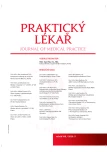Using honey dressing in treatment of non-healing wounds in elderly
Authors:
D. Vyhlídalová; R. Zeleníková
Authors‘ workplace:
Vedoucí: prof. PhDr. Darja Jarošová, Ph. D.
; Lékařská fakulta
; Ústav ošetřovatelství a porodní asistence
; Ostravská univerzita v Ostravě
Published in:
Prakt. Lék. 2020; 100(1): 13-18
Category:
Of different specialties
Overview
The aim of this prospective intervention study was to determine whether the treatment of non-healing wounds with honey reduces the number of dressings, wound secretion and wound odour as well as lower financial costs compared to conventional dressings. The research involved 40 seniors with non-healing wounds in home care who were randomly assigned to two groups. The non-healing wound in elderly from intervention group was treated with honey dressing and in control group with conventional dressing. The total number of dressings was statistically significant (p = 0,0004). A higher number of dressings was in control group. The differences between groups in wound bed status (p = 0,057) and wound secretion (p = 0,176) were not statistically significant. Statistically less odour during treatment was in intervention group (p < 0,001). Treatment of non-healing wound with honey dressing resulted in decreasing wound odour, lower number of dressing and lower financial costs compared to control group.
Keywords:
non-healing wound – Honey – Secretion – odour – healing
Sources
1. Alam F, Islam A, Gan SH, et al. Honey: a potential therapeutic agent for managing diabetic wounds. Evid Based Complement Alternat Med 2014; 2014 : 169130.
2. Asamoah B, Ochieng B, Meetoo D. The clinical role of honey in treating diabetic foot ulcers: a review. Diabetic Foot J 2014; 17 : 25–28.
3. Biglari B, Moghaddam A, Santos K, et al. Multicentre prospective observational study on professional wound care using honey. Int Wound J 2013; 10(3): 252–259.
4. Coulbourn A, Hampton S, Tadej M. Algivon: Manuka Honey v complex wounds. J Community Nurs 2009; 23(6): 25–28.
5. Cryer S. The use of manuka honey to facilitate the autoamputation of fingertip necrosis. Wounds UK 2016; 12(2): 66–70.
6. Eddy JJ, Gideonsen MD, Mack GP. Practical considerations of using topical honey for neuropathic diabetic foot ulcers: a review. WMJ 2008; 107(4): 187–190.
7. Gethin G, Cowman S. Bacteriological changes in sloughy venous leg ulcers treated with manuka honey or hydrogel: an RCT. J Wound Care 2008; 17(6): 241–244, 246–247.
8. Holland L, Norris J. Medical grade honey in the management of chronic venous leg ulcers. Int J Surg 2015; 20(4): 17–20.
9. Kalvach Z, a kol. Geriatrie a gerontologie. Praha: Grada Publishing 2004.
10. Kuckir M, a kol. Vybrané oblasti a nástroje funkčního geriatrického hodnocení. Praha: Grada Publishing 2016.
11. Labban L. Honey as a promising treatment for diabetic foot ulcers (DFU). J Med Soc 2014; 28(2): 64–68.
12. Lee D, Sinno S, Khachemoune A. Honey and wound healing: an overview. Am J Clin Dermatol 2011; 12(3): 181–190.
13. McLoone P, Warnock M, Fyfe L. Honey: a realistic antimicrobial for disorders of the skin. J Microbiol Immunol Infect 2016; 49(2): 161–167.
14. Mrázová R, Stryja J, Poch T. Medová krytí v moderním wound managementu. Hojení ran 2014; 8(1): 31–32.
15. Mohamed H. The efficacy and safety of natural honey on the healing of foot ulcers: a case series. Wounds 2015; 27(4): 103–114.
16. Moghazy A, Shams ME, Adly OA, et al. The clinical and cost effectiveness of bee honey dressing in the treatment of diabetic foot ulcers. Diabetes Res Clin Pract 2010; 89(3): 276–281.
17. Molan P. Using honey in wound care. Int J Clin Aroma 2006; 3(2): 21–24.
18. Oryan A, Alemzadeh E, Moshiri A. Biological properties and therapeutic activities of honey in wound healing: A narrative review and meta-analysis. J Tissue Viability 2016; 25(2): 98–118.
19. Shukrimi A, Sulaiman AR, Halim AY, et al. A comparative study between honey and povidone iodine as dressing solution for Wagner type II diabetic foot ulcers. Med J Malaysia 2008; 63(1): 44–46.
20. Slonková V, Vašků V. Kvalita života, sociálně – ekonomické aspekty bércových vředů a nové možnosti celkové terapie. Dermatol. praxi 2014; 8(3): 89–92.
21. Stryja J, a kol. Repetitorium hojení ran 2. Semily: Geum 2011.
22. Tian X, Li JY, Ma L, et al. Effects of honey dressing for the treatment of DFUs: a systematic review. Int J Nurs Sci 2014; 1(2): 224–231.
23. Vandamme L, Heyneman A, Hoeksema H, et al. Honey in modern wound care: a systematic review. Burns 2013; 39(8): 1514–1525.
24. Watts R, Frehner E. Evidence summary: wound management: medical-grade honey. Wound Pract Res 2017; 24(1): 61–64.
25. Zeleníková R, Vyhlídalová D. Applying honey dressings to non-healing wounds in elderly persons receiving home care. J Tissue Viability 2019; 28(3): 139–143.
Labels
General practitioner for children and adolescents General practitioner for adultsArticle was published in
General Practitioner

2020 Issue 1
- Advances in the Treatment of Myasthenia Gravis on the Horizon
- Metamizole vs. Tramadol in Postoperative Analgesia
- What Effect Can Be Expected from Limosilactobacillus reuteri in Mucositis and Peri-Implantitis?
- Hope Awakens with Early Diagnosis of Parkinson's Disease Based on Skin Odor
- Metamizole in perioperative treatment in children under 14 years – results of a questionnaire survey from practice
Most read in this issue
- Patients with limited legal capacity in general practitioners’ surgeries: what is new in Czech legislation
- Using honey dressing in treatment of non-healing wounds in elderly
- Pelvic venous congestion syndrome in clinical practice of angiologist’s point of view
- Hypercholesterolemia therapy by PCSK9 inhibitors
